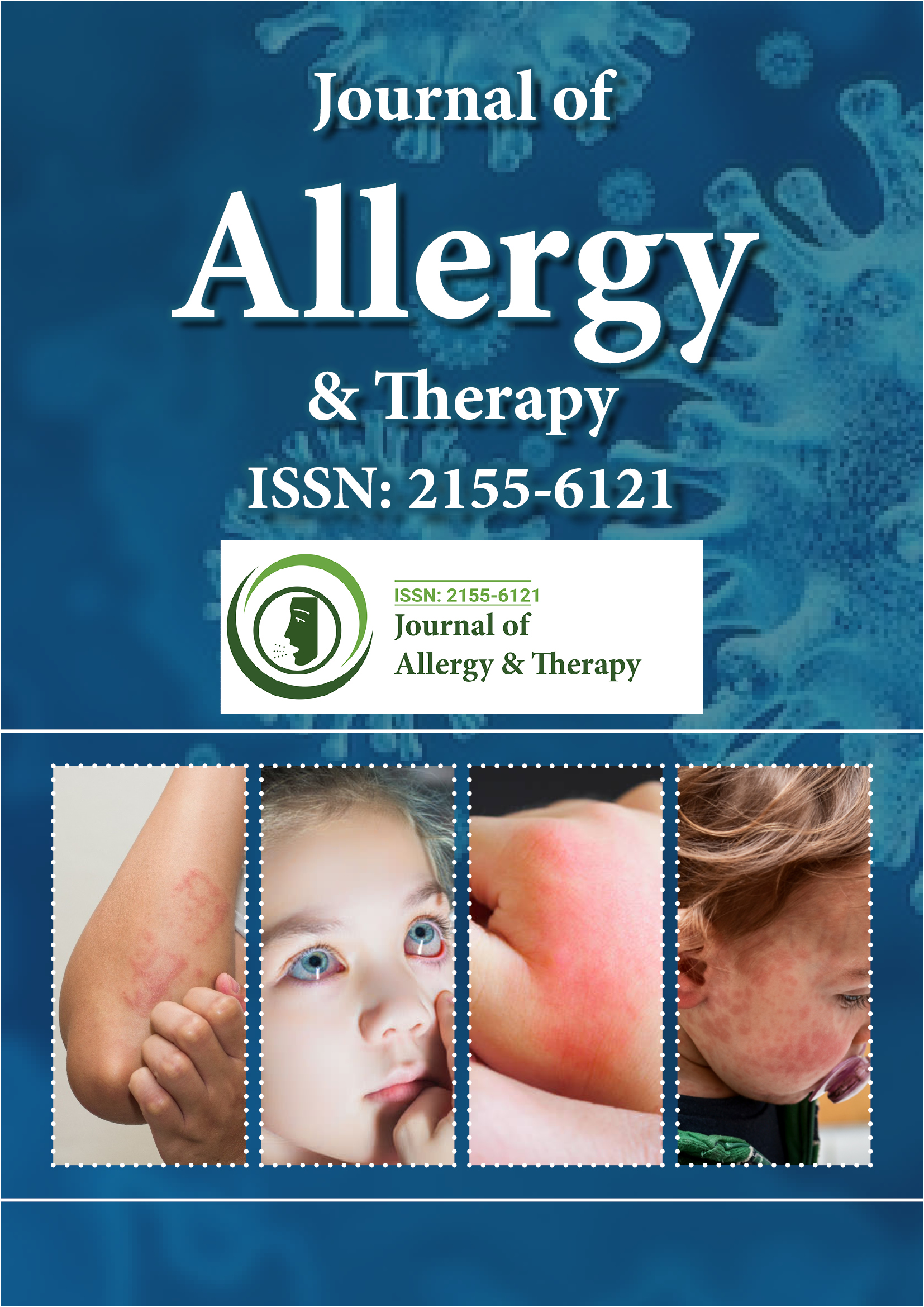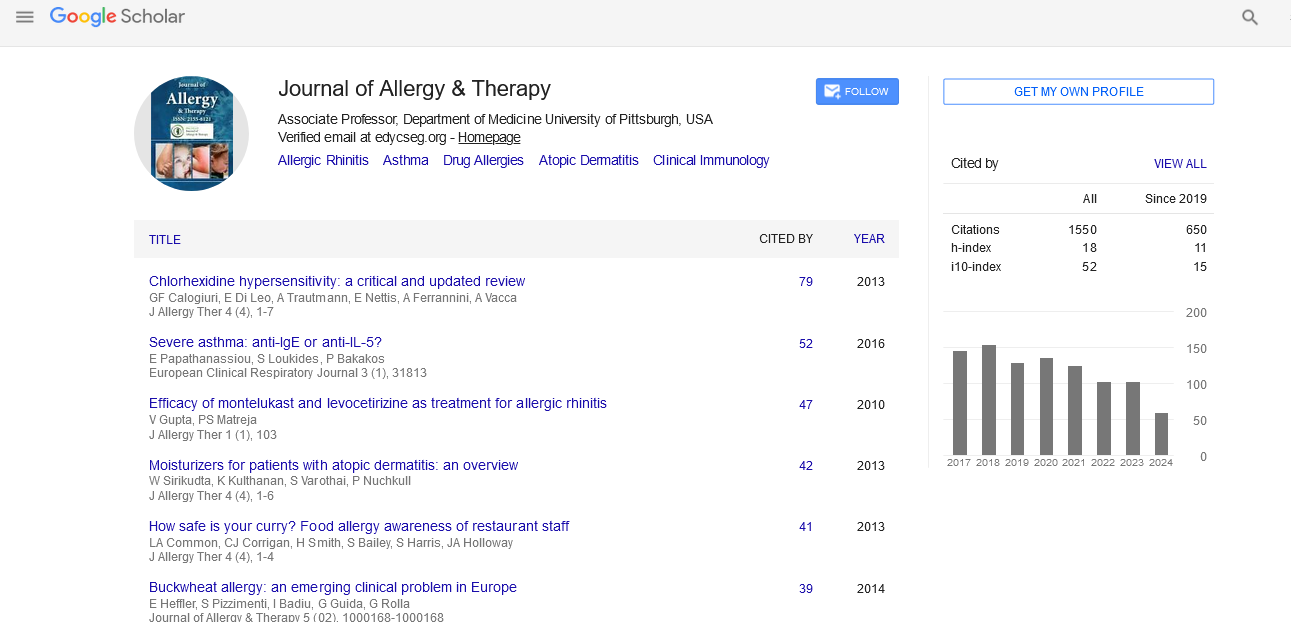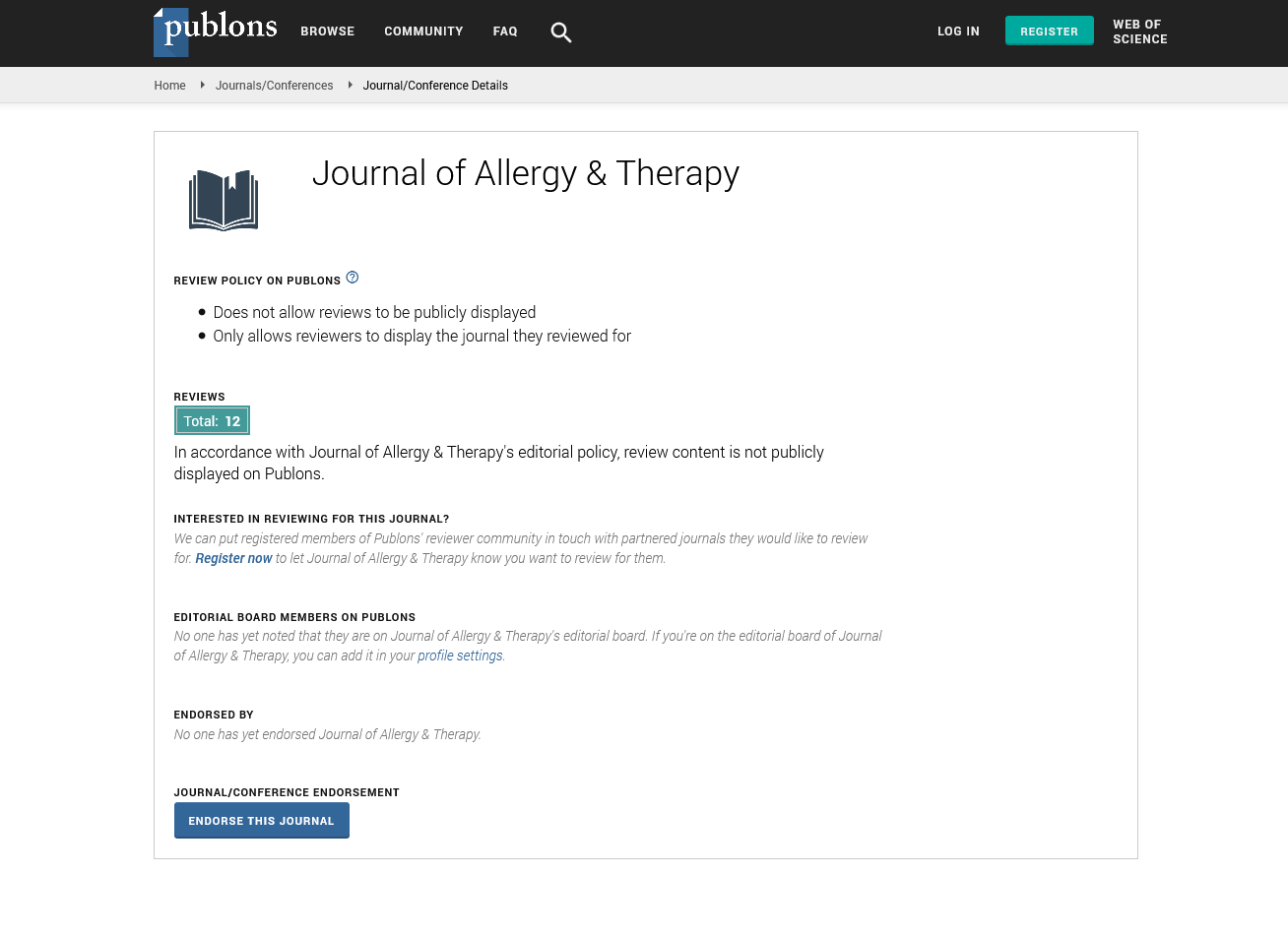Indexed In
- Academic Journals Database
- Open J Gate
- Genamics JournalSeek
- Academic Keys
- JournalTOCs
- China National Knowledge Infrastructure (CNKI)
- Ulrich's Periodicals Directory
- Electronic Journals Library
- RefSeek
- Hamdard University
- EBSCO A-Z
- OCLC- WorldCat
- SWB online catalog
- Virtual Library of Biology (vifabio)
- Publons
- Geneva Foundation for Medical Education and Research
- Euro Pub
- Google Scholar
Useful Links
Share This Page
Journal Flyer

Open Access Journals
- Agri and Aquaculture
- Biochemistry
- Bioinformatics & Systems Biology
- Business & Management
- Chemistry
- Clinical Sciences
- Engineering
- Food & Nutrition
- General Science
- Genetics & Molecular Biology
- Immunology & Microbiology
- Medical Sciences
- Neuroscience & Psychology
- Nursing & Health Care
- Pharmaceutical Sciences
Short Communication - (2022) Volume 13, Issue 7
Sensitization Caused by Occupational Allergies and Allergic Diseases
Carlos Cabral*Received: 04-Jul-2022, Manuscript No. JAT-22-17739; Editor assigned: 07-Jul-2022, Pre QC No. JAT-22-17739 (PQ); Reviewed: 22-Jul-2022, QC No. JAT-22-17739; Revised: 01-Aug-2022, Manuscript No. JAT-22-17739 (R); Published: 08-Aug-2022, DOI: 10.35248/2155-6121.22.13.297
Description
Workers in industrialized cultures are susceptible to newly emerging diseases known as occupational immune disorders. Workplace chemical exposures can result in allergic reactions, inflammatory reactions, or other immunological reactions that could be harmful. Personal exposure to a number of chemicals can aggravate respiratory conditions like rhinitis, asthma, and hypersensitivity pneumonitis as well as immunological conditions like contact dermatitis [1].
The route of exposure, the source of exposure, the environment, and heredity can all have an impact on how severe an allergic condition is. Between exposures (sensitization) and symptoms (elicitation), allergic disorders exhibit a latency phase that may involve both immunoglobulin E (IgE)-mediated and non-IgEmediated reactions. According to Gell and Coombs classification of hypersensitivity reactions, there are four fundamental hypersensitivity reactions. Based on the key effector chemicals and immune cells engaged in each reaction, the various reactions were classified. The two types of hypersensitivity reactions that occur most frequently in the workplace are Type I and Type IV (also known as IgE- and non- IgE-mediated, respectively) [2].
High-molecular-weight allergen and low-molecular-weight allergen mediated responses can be used to stratify occupational allergies. Many immunologic mechanisms regulate allergic sensitivity to these occupational allergens. By producing IgE antibodies, High-Molecular-Weight (HMW) allergens (usually proteins) cause type I hypersensitivity reactions or conventional allergies. These reactions include a range of symptoms, such as rhinitis (rhinosinusitis, conjunctivitis), hives, asthma, and potentially fatal anaphylaxis [3]. Patients with asthma brought on by an HMW allergen exhibit increased frequency and severity of the early-phase response but less frequently a late-phase response. Episodic occupational outbreaks of reactions to HMW allergens can be severe and drastically disrupt a person's life.
These allergies, like latex allergy and Baker's asthma, can affect a lot of easily identifiable workers in certain industries and can even become epidemic in scope. It can manifest locally or in less clearly defined populations, such as in agricultural or food processing workers who have been exposed to soy, seafood, pollens, moulds, and other contaminants. Identification and characterisation of high-molecular-weight occupational allergens are among the research topics, some of the identified fungal enzyme allergens and go over monitoring and avoidance tactics using fungal enzymes as a prototypic HMW occupational allergen. Proteomics, molecular methods, the creation of recombinant allergens, the production of monoclonal antibodies, and other methods are used to characterise HMW allergens in order to produce immunoassays and improve workplace allergy detection [4].
Low-molecular-weight allergens, which are often chemicals, cause type 4 hypersensitivity reactions by activating T cells that are unique to the allergen. These reactions can cause contact dermatitis as well as sensitizations that can trigger severe asthma. Patients with asthma brought on by LMW allergens are more likely to exhibit a late-phase airway reaction. Our study describes the identification of low-molecular-weight allergens in the lab using the local lymph node assay to ascertain whether newly introduced chemicals can result in workplace sensitizations as well as testing various components to identify the specific sensitizer and potentially nonsensitizing replacements. Using a variety of assays from a thorough tiered approach, they looked at how chemical exposure affected immune function [5].
Conclusion
The National Toxicology Program has adopted this for use in identifying harmful consequences following chemical exposure (in rodents), which suggested Ortho-Phthalaldehyde (OPA) as a replacement for glutaraldehyde as a sterilant in the healthcare business, highlights the value of examining prospective replacement chemicals. Their laboratory results revealed that the chemical OPA substitution is likewise a potent sensitizer. Building improved models that predict whether chemicals are allergens requires the development of novel techniques for screening chemicals for possible sensitizer.
REFERENCES
- Simpson EL, Bieber T, Guttman-Yassky E, Beck LA, Blauvelt A, Cork MJ, et al. Two phase 3 trials of dupilumab versus placebo in atopic dermatitis. N Engl J Med 2016;375(24):2335-2348.
[Crossref] [Google Scholar] [Pubmed]
- Beck LA, Thaçi D, Deleuran M, Blauvelt A, Bissonnette R, de Bruin-Weller M, et al. Dupilumab provides favorable safety and sustained efficacy for up to 3 years in an open-label study of adults with moderate-to-severe atopic dermatitis. N Engl J Med. 2020;21(4):567-577.
[Crossref] [Google Scholar] [Pubmed]
- de Bruin‐Weller M, Thaçi D, Smith CH, Reich K, Cork MJ, Radin A, et al. Dupilumab with concomitant topical corticosteroid treatment in adults with atopic dermatitis with an inadequate response or intolerance to ciclosporin A or when this treatment is medically inadvisable: A placebo‐controlled, randomized phase III clinical trial (LIBERTY AD CAFÉ). Br J Dermatol. 2018;178(5):1083-1101.
- Simpson EL, Bieber T, Guttman-Yassky E, Beck LA, Blauvelt A, Cork MJ et al. Two phase 3 trials of dupilumab versus placebo in atopic dermatitis. N Engl J Med. 2016;375(24):2335-2348.
[Crossref] [Google Scholar] [Pubmed]
- Thaci D, Simpson EL, Beck LA, Bieber T, Blauvelt A, Papp K, et al. Efficacy and safety of dupilumab in adults with moderate-to-severe atopic dermatitis inadequately controlled by topical treatments: A randomised, placebo-controlled, dose-ranging phase 2b trial. Lancet. 2016;387(10013):40-52.
[Crossref] [Google Scholar] [Pubmed]
Citation: Cabral C (2022) Sensitization Caused by Occupational Allergies and Allergic Diseases. J Allergy Ther. 13:297.
Copyright: © 2022 Cabral C. This is an open access article distributed under the terms of the Creative Commons Attribution License, which permits unrestricted use, distribution, and reproduction in any medium, provided the original author and source are credited.


